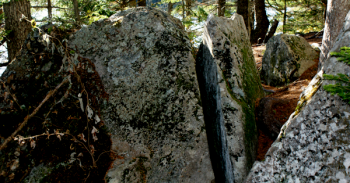Ask Professor Puzzler
Do you have a question you would like to ask Professor Puzzler? Click here to ask your question!
"Hi Professor Puzzler, in last week's post you said that if a number is irrational, it doesn't terminate or repeat. I wonder how you know that? Of all the irrational numbers, how do you know there isn't one that terminates or repeats?"
This question comes from Trevor in Georgia.
Hi Trevor, in answer to your question, I'll give you a short proof (with a bit of hand-waving over some details, just to keep the write-up from being too long!). What we'll do is, we'll start with numbers written in decimal notation, which we'll assume are irrational (which means, as you remember from the post about the square root of two, that it can't be written as a ratio of integers) and then we'll arrive at a contradiction, which will prove that they aren't irrational. So let's get started!
Terminating Decimal
Let n be an irrational number with a terminating decimal. This means that after a certain number of decimal places (let's call that k), the decimal ends.
Since the decimal terminates after k decimal places, the number 10kn is an integer (every time you multiply by 10, you shift the decimal one place to the right, so multiplying n by 10k results in all the digits being to the left of the decimal).
Now we can write n = (10kn)/(10k), which is ratio of two integers, and that contradicts our original assumption that n was irrational. Thus, if a number in decimal form terminates, it is not irrational.
Repeating Decimal
Let n be an irrational number with a repeating decimal. This means that after a certain number of decimal places (let's call that k), the decimal begins repeating every h digits, where h is some integer.
For example, if the number is 3.125727272..., k = 3, h = 2.
To simplify our math, let's multiply our number by 10k, which allows us to get the non-repeating part of the decimal over to the left of the decimal. We understand that when we're done with our manipulations, we have to divide by 10k to get our number back, but if we've proven that our result is rational, then dividing by 10k still gives us a rational number.
Similarly, everything to the left of the decimal can then be subtracted, with the understanding that when we're done we must add it back in. But the same argument holds; if we've proved the result is rational, adding an integer to that rational number will result in another rational number.
In other words, we can, without loss of generality, simplify our starting point to a decimal which looks like this:
n = 0.a0a1...aha0a1...aha0a1...ah...
Let m be the integer formed by the following digits: a0a1...ah
Then n = m/(10h) + m/(102h) + m/(103h) + ...
This is an infinite series with common ratio 1/(10h), and its sum is:
S = [m/(10h)]/[1 - 1/(10h)]
S = m/(10h - 1)
Since m is an integer, and 10h - 1 is an integer, we've shown that our number can be expressed as a ratio of integers, which contradicts our assumption that it is irrational. From this we've shown that if a decimal repeats or terminates, it is not irrational.
Thanks for asking, Trevor!
"In your post about triangular mountains, you mentioned ice wedging - can you explain what that is?"
Sure! In fact, I'll do better than just explain; I'll also give a picture. First the explanation. Ice wedging is a form of erosion. And erosion, in case you don't know, is when something breaks down due to wind, water, or other natural forces. Erosion can easily be seen on a mountain trail, where water rushes down the side of the mountain (usually in the spring time, but after any heavy rain) and washes away the dirt. This is why, if you're hiking a mountain, you'll often find trails covered with tree roots. The roots weren't always exposed; the rain washed away the dirt until they were sticking out.
This is also why, on many steep mountain trails, the people who maintain the trails will put logs across the trail at intervals, diagonally placed in such a way that water rushing down the trail will be diverted off into a ditch by the side of the trail. These kinds of devices are called "waterbars," because they are designed to bar the water from flowing down the trail and eroding it.
Okay, so that's erosion, and "ice wedging" is a form of erosion. Ice wedging happens when a rock has a crack in it. When it rains, the crack fills up with water. Now, that's not really a big deal, unless that water freezes inside the crack. Since water expands when it freezes, there's not enough space for all that ice in the crack, so the two sides of the crack get pushed apart by the ice, which causes the boulder to shift, and maybe crack some more. If this process happens repeatedly, the crack gradually becomes bigger and bigger, and eventually the boulder may split entirely.
This is very common at high altitudes, where the temperatures fluctuate a lot from day to night; during the spring time there will be lots of rain, and lots of running water from melting snow, but at night the temperatures drop below freezing.
Here's an example of a boulder near the summit of Cranberry Peak in Stratton, Maine, that was probably split due to ice wedging.

"I have two questions. First, why are irrational numbers called irrational? Doesn't that mean "not logical?" Second, how do we know that the square root of 2 is irrational?" 11th grader Howard
Well, Howard, you're right that "irrational" means "not logical," but that's not the only meaning the word can have. Instead of breaking the word down as ir-rational, break it down this way: ir-ratio-nal. Instead of meaning "not rational," the word "irrational" means "not a ratio." And this is actually the definition of an irrational number; it is a real number which cannot be written as the ratio (or fraction) of two integers.
We often describe irrational numbers as numbers which have a non-repeating, non-terminating decimal, but that's just a description, not the definition of an irrational number; it's a consequence of the fact that it can't be written as a ratio of integers.
So when we say that the square root of two is irrational, we're saying there are no two integers that when you divide one by the other, we get the square root of two.
Can we prove that the square root of two is irrational? Yes, we can. I'll provide you with an informal proof in the following paragraphs.
We'll begin by assuming that the square root of two is not irrational. In other words, that it can be written as a ratio of two integers. If we make this assumption, and then obtain a contradiction, then we'll have proven that our assumption was wrong. In other words, we'll have proved that the square root of two is irrational.
Since we're assuming that the square root of two is rational, then that's the same as assuming that there exists a fraction in simplest form a/b such that a/b = SQR(2). Note that simplest form implies that a and b are relatively prime integers. If we square both sides of this equation, we obtain the following:
a2/b2 = 2, or a2 = 2b2.
Since b (and therefore b2) is an integer, we can conclude that a must be a multiple of 2, since it is equal to twice an integer.
Since a2 is the square of a multiple of 2, it is a multiple of 4. (as a side note, you might find this interesting: all perfect squares are either a multiple of 4, or one more than a multiple of 4.)
But by the same reasoning above, we can conlude that therefore, b must be a multiple of 2, because when multiplied by 2 it results in a multiple of 4.
Aha! Here's the contradiction we needed; we started with the assumption that a and b were relatively prime, and have ended up proving that both a and b are multiples of 2, which means they are not relatively prime.
Since we've created a contradiction, we've proved our original assumption wrong, from which we can conlude that the square root of two must be irrational.

6th grader Vanshika from Kolkata asks the following question: "Why are mountains in a triangular shape???"
Hi Vanshika, strictly speaking, mountains aren't triangular shaped, since a triangle is a two dimensional shape, and mountains are three dimensional. I suppose we could talk about cones, instead of triangles, as in this picture, which is a mountain I've hiked several times, named Kearsarge North (Intervale, New Hampshire).
Most mountains, though, are not quite so nicely conical; here's a picture of another one of my favorite mountains - Bigelow Mountain in Stratton, Maine. This mountain has five or six peaks stretched out across a ridge that takes a couple days to cross.

And yet...one day I was approaching this mountain from a different angle, and didn't recognize it, because it looked like one giant triangle. I was looking at the end of the mountain, so all I saw was a single peak, which was very clearly triangular!
So instead of saying that mountains are cones (which they aren't, for the most part) maybe we could say their cross sections are often triangular. Do you know what a cross section is? A cross section is the open face you would get if you took a knife and sliced it in a perfectly straight line through the mountain. For example, if you cut an orange in half, the cross section would be a circle. If you cut a box in half, the cross section would be a rectangle. So maybe we could say that if you cut a mountain perpendicular to its ridge-line, you would most likely get something that is approximately a triangle shape. Even that isn't going to be 100% true, but it's a pretty good "rule of thumb" for most of the mountains I've hiked. The key idea is that they are wider at the base than at the top, like a triangle.
But your question remains: Why are mountains shaped this way?
Let me try to put this in a simple way. My son (who is not quite four years old) likes to play in the sand. One of the things he enjoys doing in the sand is "building towers." His idea of building a tower is to pour sand in one place. The sand turns into a small pile, and that pile gets larger the more sand he puts on it. It doesn't take long before the sand that he's pouring on starts sliding down the sides of the pile, making the pile not just taller, but also wider at the base. He's forming a cone.
Why does this happen? Well, there are two forces acting on the particles of sand. One of them is the force of gravity pulling the sand toward the ground. The other is the force of friction. Friction is what keeps two objects from sliding past each other. Imagine sliding two pieces of paper against each other, then imagine sliding two pieces of sandpaper against each other. Sliding the sandpaper will be harder to do, because of the roughness of the two pieces of paper. We say that there is more friction between them.
These two forces are competing against each other. The force of gravity is pulling the sand down, while the force of friction is holding it in place. The amount of gravitational force which causes motion varies depending on the slope (or angle) of the surface on which the particle of sand is resting. Thus, if the pile is steep, gravity outweighs friction, but if the angle is shallow, friction wins. Therefore, as my son pours that sand, once it has piled up to the point that gravity outweighs friction, the sand starts sliding down the side, until the base has spread out enough that the slope is shallow again, and friction outweighs gravity once more.
Can you visualize that?
Hopefully, after that explanation, you're thinking to yourself, "Yeah, but the mountains weren't formed by pouring sand out of the sky!"
Right you are! Mountains are formed by different processes than pouring sand. In fact, if you've ever been on a mountain, you know that in many cases, they are made of mostly rock, not sand. Mountains are formed by tectonic forces, earthquakes, and even volcanic eruptions. While these forces are in play, the same principles of friction and gravity still hold true, resulting in the familiar triangle shape.
And once a mountain is formed, it is subject to forces of erosion - rain washing the soil away, landslides, crumbling rocks, etc. And these forces function in similar ways to what was described above. The steeper a mountain is, the more heavily it is affected by erosion, leading, over time, to a generally triangular shape.

Of course, it's possible for a mountain to be very lopsided; we haven't said that the triangular shape will be symmetrical. Here's a picture I took when I went hiking with my little boy yesterday.
This mountain is called Tumbledown Mountain. Would you like to know why? Because it is believed that, long long ago, the side of this mountain tumbled down. One entire face of the mountain simply collapsed, leaving a very steep (cliff-like) slope. Why did this happen? Perhaps the granite weakened at the bottom through ice-wedging and other erosional forces, and when the weakened granite collapsed, everything above it collapsed as well.
Well..almost everything above it collapsed. Here's a picture taken from the top of that cliff.

Notice how that rock ledge hangs out over empty space? Once upon a time it wasn't like that; there was solid rock below it. Now all that rock is in a heap at the bottom of the mountain, while this one remaining piece of rock hangs out precariously 2000 feet above ground!
Aren't mountains great?
Vusi from South Africa wants to know - if you roll a blue die and a yellow die, why are these considered to be independent events?
Well, Vusi, let's start off by making sure we understand the terms "dependent events" and "independent events."
Dependent Events
Two or more events are dependent if the outcome of one of the events will affect the outcome of the other.
For example, if you have a jar that contains 100 blue jelly beans and 100 yellow jelly beans, and you draw one jelly bean and eat it. The probability that the jelly bean will be blue is 0.5 (100/200, because there are 100 blue jelly beans and a total of 200 jelly beans all together). However, if you then draw a second jelly bean from the jar, the probability of it being blue is not 0.5. In fact, we really don't know what the probability is. Why? Because if the first draw was a blue, the probability will be 99/199 (because we have one less blue, and one less total), but if the first draw was yellow, the probability of a blue on the second draw will be 100/199 (because we still have 100 blues, but one fewer yellow). Thus, the probability of the second event can't be calculated without knowing the result of the first event. The first event affects the outcome of the second event. These are therefore dependent events.
Independent Events
Two or more events are independent if the outcome of one event has no effect on the outcome of another.
To keep this simple, let's talk about the same jar. Only this time, instead of eating the jelly bean, you put it back in the jar after drawing it out. The probability that the first jelly bean drawn is blue is 0.5. But what about the second drawing? In the second drawing, you still have 100 blue jelly beans and a total of 200, because the first jelly bean drawn was put back in. Thus, it makes no difference what you draw the first time; the probability for the second draw being blue is still 0.5. The first draw does not affect the second draw, so these are independent events.
Hopefully, with this in mind, you can answer your own question. Are the rolls of a blue die and a yellow die independent? Yes they are! Because the roll of the blue die is not going to affect the roll of the yellow die. The yellow die isn't going to think, "Oh, the blue die is showing a 3, so I better not land on 3," or "The blue die is showing an even number, so I should show an odd," or "Hey, the blue die is showing a 6, so if I land on 6 we'll have doubles!" Whatever happened with the blue die has absolutely no bearing on what happens with the yellow die. Therefore, these are independent events.
By the way, we have a reference unit on probability on this site, which you can find here: Probability concepts and problems. This unit contains a section on independent events and dependent events, so you can read more on that here: Independent Events, Dependent Events.
Thanks for asking!


